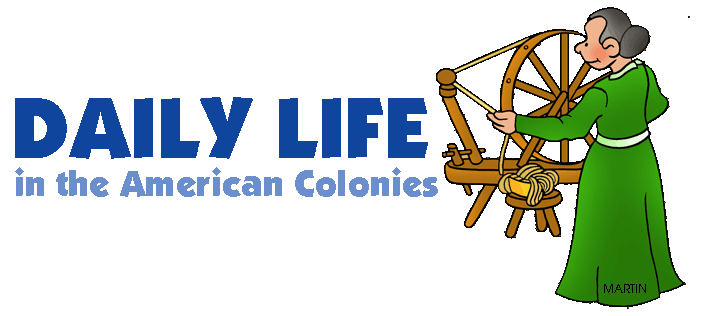For Kids
Clothing in the New England Colonies: The Quakers and the Puritans believed that everything should be plain. Back in England, women's clothing at the time was very fancy, with gowns made out of velvets and satins, decorated with lace and frills and buttons and bows. Men's clothing was also fancy with buckles and buttons and even fans. These early colonists wanted nothing to do with fancy and frill because it reminded me of the very rules and customs and beliefs they had left England to escape. There was another reason for simple clothing. Except for the very rich, for the most part, people made their own clothes so clothes had to be simple, warm, and sturdy.
-
Men's Clothing: Men's clothing was made from wool, leather, and linen. The men wore loose linen shirts. Their pants reached only to the knee. Their socks were long and woolen. They wore a sleeveless jacket. (Sometimes they wore a padded jacket with sleeves, especially in colder weather.) They wore plain leather shoes, wide brimmed hats, and coats or capes for protection from cold or rain. Shirts were white. The rest of their clothes were typically brown or black.
-
Women's Clothing: As women dressed, first they put on a long loose dress. Sometimes the sleeves were removable and tied on. Over that, they wore a long gown made of wool or linen. Over that they wore a plain apron. All their clothes were held in place by tying them. Their hair was pulled up and tucked under a coif (a fabric hat or top piece). They wore long woolen socks. Their shoes were made of sturdy leather. They also wore capes or coats to protect them from the elements.
-
Kids Clothing: Until they were age 7, both boys and girls wore simple gown or shifts. Over the age of 7, they wore clothes designed like their parents.
-
Servants: Some colonists had servants. As in England, servants clothing was traditionally blue. Indigo dye (deep blue dye) was available and cheap, so servants could always be recognized by the color of their clothing - blue.
-
Not everyone in New England wanted plain clothes. As time went on, and towns grew, some women hired others to make their family's clothes and shoes. A dressmaker and a shoemaker came to work in some of the homes for a few days each year. Some dressmakers and shoemakers remained in the towns, as they grew large enough to support them.
Clothing in the Middle Colonies: In the Dutch settlements, girls wore full red skirts and the boys wore long baggy pants, red stockings, beaver caps, and a shirt. There were also German, Scotch, English, and Irish settlements. As in the New England colonies, clothes were simple. Much time was spent in church, in cleaning, and in growing and harvesting and storing food. Except in the cold winter months, there was not a lot of time left over to make fancy clothes.
Clothing in the Southern Colonies: Things were different in the south. Like people in the north, the earliest settlers were busy trying to survive. In these early days, clothes were as simple as possible. Women wore cotton dresses and petticoats. Girls wore cotton dresses. Men wore breeches to the knee, a shirt, a hat and boots or shoes. As the plantations developed, woman with leisure time began to ape the styles that were popular back in England. They were usually behind the times, and sometimes completely wrong, as their gowns were based on letters and pictures, but they tried. For the most part, the men stayed with their breeches and boots, as usual.
How to make colonial costumes with homemade items
For Teachers
Free Use Lesson Plans and Classroom Activities for Colonial America
Free Use Presentations in PowerPoint format about Colonial America

